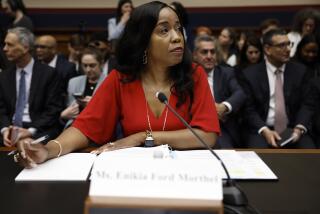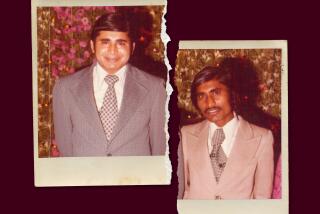Linked by DNA, Man Admits to 6 Slayings
The man accused of being the “60 Freeway Slayer,” who terrorized the San Gabriel Valley in the early 1990s by strangling six woman, won’t dispute that he is the killer as his trial gets underway this week.
The revelation, contained in court papers, ends the 13-year mystery of who was responsible for the grisly killings, which all took place in communities along the Pomona Freeway.
Ivan J. Hill, who was linked to the crimes a decade later through DNA evidence, will center his defense not on whether he committed the crimes but on whether he should get the death penalty.
Prosecutors outlined in court papers how Hill allegedly roamed the San Gabriel Valley late at night looking for victims.
He worked by day as a warehouse “romper” in a series of low-paying industrial jobs in and around the area. At night, he often cruised the gritty streets near Mission and Holt avenues in Pomona looking for prostitutes, officials said.
It was there that Hill allegedly victimized half a dozen prostitutes whose discarded bodies turned up along a 30-mile section of the 60 Freeway corridor stretching from the City of Industry to Ontario.
Hill will not deny that over a 10-week period beginning in November 1993, he killed Betty Sue Harris, Roxanne Brooks Bates, Helen Hill, Donna Goldsmith, Cheryl Sayers and Debra Denise Brown.
Instead, the case will focus on whether the crimes of the so-called 60 Freeway Slayer constituted first-degree murder deserving of the death penalty.
Lawyers on both sides would not comment for this article. But they provided the outlines of their respective cases last week before a pool of about 300 potential jurors in the courtroom of Los Angeles County Superior Court Judge Larry P. Fidler.
Hill’s defense team is expected to call several dozen witnesses who will speak to the defendant’s troubled background.
Using medical experts, they will also make the case that Hill’s actions could not have been premeditated because of his mental condition at the time of the killings.
Prosecutors will let Hill’s extensive criminal background as well as the grisly details of the killings -- including that victims were tied up and strangled with ligature -- make the case for them.
Hill’s victims, all African American and in their 30s, were strangled and their bodies dumped in industrial areas, city parks or by roadsides.
Some were found with duct tape over their mouths, others with their ankles or wrists bound.
When the slayings began, authorities first denied a connection.
But when Pomona police detectives discovered the body of Sayers, 36, in the Ganesha Park section of Pomona early on Dec. 30, 1993, it was a moment of clarity for authorities.
Sayers was the third woman found dead in Pomona in less than a month with a similar background -- prostitutes who dropped out of school at early ages, were unmarried mothers with spotty work histories and minor criminal records.
They then knew they were dealing with a serial killer.
Investigators with the Pomona, Upland and Ontario police departments and the Los Angeles County Sheriff’s Department began working together to investigate the slayings.
They were able to link two other homicides -- that of Harris, 37, of Pomona, who was found dead Nov. 1 in a business park in Diamond Bar; and Bates, 31, of Pomona, who was found Nov. 5 on a rural road in Chino -- to the same killer.
Even so, they had no suspect.
In early 1994, the murder spree ended. That coincided, prosectors now contend, with Hill going back to prison after his arrest and conviction for a series of armed robberies.
In March 2003, a DNA sample from biological evidence gathered in the Harris slaying was linked to Hill.
That was followed by five other “cold hits.”
Deputy Dist. Atty. John Monaghan is expected to introduce tape of a 911 call made by Hill to Pomona police that led authorities to the body of victim Brown on Jan. 12, 1994. She was found face down in San Antonio Park in Ontario.
Also, jurors will see the letter that Hill wrote to a relative from jail when he was being interviewed about the killings in late 2003.
He said, “I knew this day would come when they came with the DNA samples.”
*
More to Read
Start your day right
Sign up for Essential California for news, features and recommendations from the L.A. Times and beyond in your inbox six days a week.
You may occasionally receive promotional content from the Los Angeles Times.






